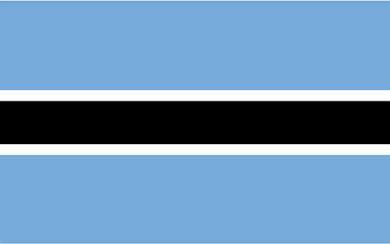Flag of Botswana
The water is gotten from downpour, despite the fact that Botswana encounters a successive absence of precipitation and water is in this manner a scant and valuable ware in the huge Kalahari Desert. The high contrast tones represent accord and cooperation among individuals of different races and societies living in Botswana, as well as the pluralist idea of the general public. It likewise addresses the stripes of a zebra, which is viewed as an image of normal overflow and is Botswana's national creature. The flag has a width-to-length extent of 2:3.
Tones AND Imagery OF THE BOTSWANA FLAG
The flag of Botswana is a light blue field that is separated through the middle by a dark line with a white boundary around it. The light blue field is an emblematic portrayal of the downpour that is so significant in Botswana because of the country's by and large parched environment. The high contrast lines are suggestive of the zebra populaces that are normal in Botswana, however they additionally address the tranquil concurrence of the residents who are plummeted from European pioneers with the residents who are plunged from local Africans. The straightforward and downplayed plan was expected to offer areas of strength for a to the flag of South Africa, which was managed by a politically-sanctioned racial segregation government that didn't empower that sort of tranquil concurrence.
Buy Botswana Flags from the UK flag specialist. Flags of Botswana are available to buy online now in a range of sizes including wavers, table flags and flags for flagpoles. All our Botswana Flags are 100% Premium Polyester suitable for indoor and outdoor use.
Botswana Flag in stock to buy now
Standard Delivery takes 4-5 working days, and Next Day options are available in checkout
Prices include VAT
Flag material: 75 denier polyester fabric
8ft x 5ft, 5ft x 3ft and 3ft x 2ft flags all have 2 metal eyelets on the fly (left hand) side for hanging or flying
8ft x 5ft, 5ft x 3ft, 3ft x 2ft and 18x12inch flags have double-stitched hems for durability
Perfect for any events, celebrations and displays
HISTORY OF THE FLAG OF BOTSWANA
Botswana was a peculiarity among English settlements since it didn't have a frontier flag to address it inside the English Realm. The English flag was much of the time utilised as a casual Botswana flag, yet there was no legitimate approval for that utilisation. The province, which was known as Bechuanaland while it was important for the English Realm, just didn't have a flag to consider its own until it accepted its freedom and started to call itself Botswana.
Consequently Botswana acquired its most memorable national flag when it acquired its autonomy from the English Domain in 1966. The flag was planned before the country turned out to be officially autonomous so it may very well be shown on the absolute first day of the new country's presence. The flag's creators planned it to be an image of trust and a superior future, so they painstakingly planned that flag to remind individuals that they could stay away from the issues that were grasping different countries in Africa. The flag was well known with individuals of Botswana, and it has been utilised with practically no progressions since it was first embraced.
The National Crest Of Botswana
Botswana's crest was taken on January 25, 1966, and depends on the plans by Isabel Fawcus. It contains a focal safeguard upheld by two zebras. The zebras represent the significance of natural life, through the travel industry in the national economy. The high contrast stripes of the zebra address the fairness surprisingly of all varieties in Botswana. The zebra on the left clutches a tusk of ivory - representative of the previous ivory exchange. The zebra on the right holds an ear of sorghum - a significant harvest to the country. Inside the safeguard are three cogwheels addressing industry, three waves representing water, and the top of a bull to portray the significance of steers crowding in Botswana. The national maxim "Pula" suggesting precipitation, trust, and trust from here on out, is shown on a blue strip set at the lower part of the emblem. The blue shade of the crest indicates the core value and furthermore features the significance of water to Botswana.
Verifiable Monetary forms Of Botswana
The first cash of Botswana was the South African Rand. The presentation of Pula in 1976 supplanted the South African Rand. Banknotes were imprinted in categories of 10, 5, 2, and 1 Pula. In 1978, the initial 20-pula note was presented. From 1991-1994, the 1-pula banknote and 2-pula banknotes were supplanted by coins. In 2000, the 5-pula banknote was likewise supplanted with a coin. The first banknotes were ended and are as of now not a piece of the flow. In 2005, Pula degraded by 12%. In 2009, the most recent Pula notes were presented and the initial 200-pula note was presented. Pula is still among the most grounded monetary forms in Africa.



Comments
Post a Comment